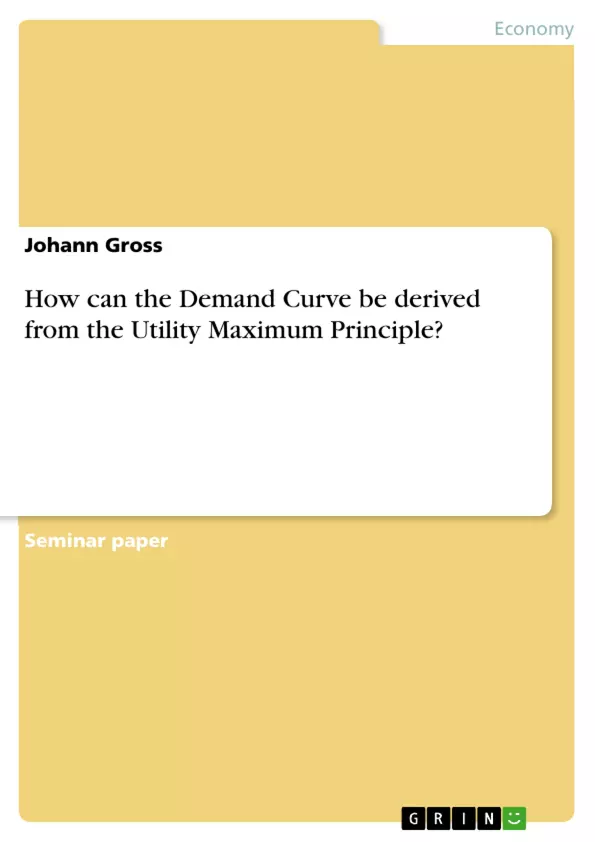This assignment shows how the demand curve can be derived by the utility maximum principle. To get this answer the author will firstly define the main issues out of the top-ic. The result is that for theoretical models like the demand curve or the utility maximum principle it is necessary to have perfect markets with perfect marketers. These perfect marketers are the so called homo oeconomicus which act rational and compare every possible opportunity with their opportunity costs to get the optimal benefit by a given income and a defined price. At least with the help of the budget line which charts the available income and the indifference curve which describes the optimal demanded unit of a good bundle, the demand curve can be derived.
Inhaltsverzeichnis (Table of Contents)
- Executive Summary
- Table of Contents
- List of Abbreviations
- List of Figures
- Introduction
- Problem Definition
- Objectives
- Methodology
- Theoretical Background: Definitions and Explanations
- Supply, Demand and how Markets Establish: A short Introduction
- The Demand on Economical Markets and its Influencing Factors
- Utility Maximum Principle
- Utilitarianism and the Welfare
- Utility Function
- Economical Principle
- How the Demand Curve can be derived from the Utility Maximum Principle
- Results and Conclusion
Zielsetzung und Themenschwerpunkte (Objectives and Key Themes)
This assignment aims to demonstrate how the demand curve can be derived from the utility maximum principle. It examines the concept of perfect markets, including the role of the "homo oeconomicus," and utilizes the tools of the budget line and indifference curves to illustrate the relationship between income, prices, and consumer demand.
- The concept of perfect markets and their role in economic modeling.
- The behavior of rational consumers ("homo oeconomicus") and their decision-making processes.
- The relationship between utility maximization and consumer demand.
- The use of budget lines and indifference curves to visualize and analyze consumer choices.
- The derivation of the demand curve from the utility maximum principle.
Zusammenfassung der Kapitel (Chapter Summaries)
- Introduction: This chapter introduces the assignment's purpose, outlining the problem of deriving the demand curve from the utility maximum principle. It also establishes the methodology and objectives of the study.
- Theoretical Background: Definitions and Explanations: This chapter delves into the theoretical foundations, defining key concepts such as supply, demand, and the utility maximum principle. It explores the influence of factors on demand in economic markets and provides a comprehensive understanding of the utility maximum principle, including utilitarianism, utility functions, and the economic principle.
- How the Demand Curve can be derived from the Utility Maximum Principle: This chapter presents the core of the assignment, demonstrating how the demand curve can be derived using the utility maximum principle. It utilizes the tools of budget lines and indifference curves to illustrate the relationship between income, prices, and consumer choices, ultimately deriving the demand curve through graphical representation.
Schlüsselwörter (Keywords)
This work focuses on the key concepts of perfect markets, "homo oeconomicus," utility maximization, budget line, indifference curves, and the derivation of the demand curve. It explores the relationship between consumer behavior, economic principles, and the theoretical model of the demand curve.
- Citation du texte
- Diplom-Kaufmann (FH) Johann Gross (Auteur), 2013, How can the Demand Curve be derived from the Utility Maximum Principle?, Munich, GRIN Verlag, https://www.grin.com/document/266629



